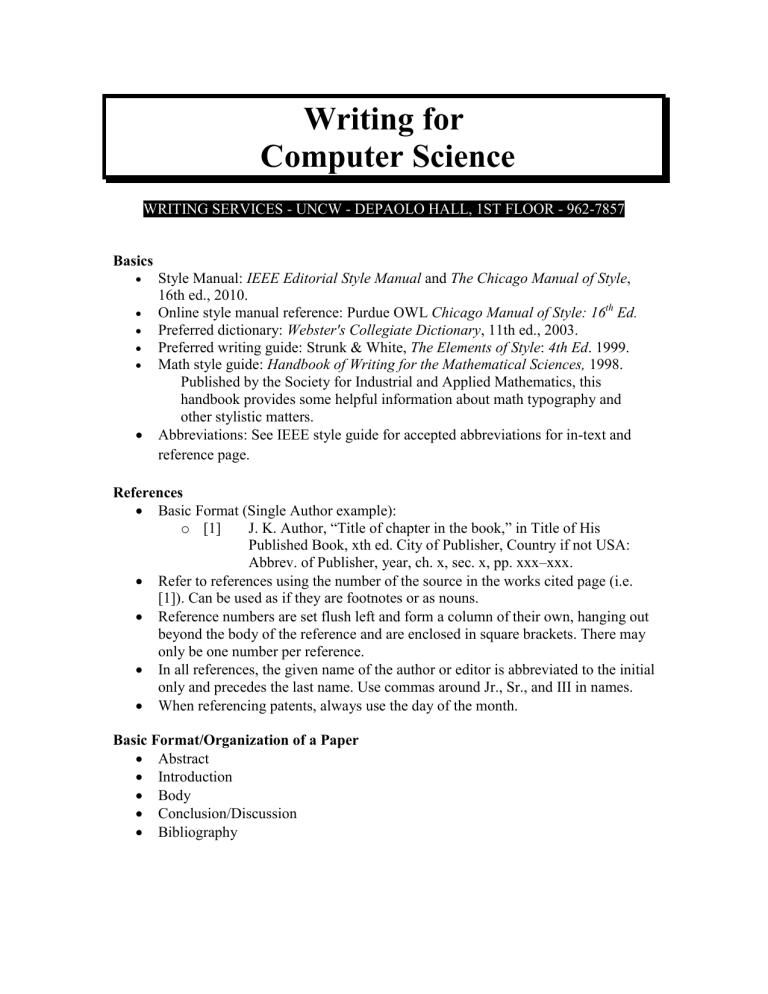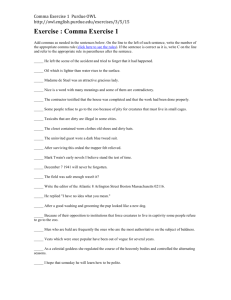Writing for Computer Science

Writing for
Computer Science
WRITING SERVICES - UNCW - DEPAOLO HALL, 1ST FLOOR - 962-7857
Basics
Style Manual: IEEE Editorial Style Manual and The Chicago Manual of Style ,
16th ed., 2010.
Online style manual reference: Purdue OWL Chicago Manual of Style: 16 th
Ed.
Preferred dictionary: Webster's Collegiate Dictionary , 11th ed., 2003.
Preferred writing guide: Strunk & White, The Elements of Style : 4th Ed . 1999.
Math style guide: Handbook of Writing for the Mathematical Sciences, 1998.
Published by the Society for Industrial and Applied Mathematics, this handbook provides some helpful information about math typography and other stylistic matters.
Abbreviations: See IEEE style guide for accepted abbreviations for in-text and reference page.
References
Basic Format (Single Author example): o [1]
J. K. Author, “Title of chapter in the book,” in Title of His
Published Book, xth ed. City of Publisher, Country if not USA:
Abbrev. of Publisher, year, ch. x, sec. x, pp. xxx–xxx.
Refer to references using the number of the source in the works cited page (i.e.
[1]). Can be used as if they are footnotes or as nouns.
Reference numbers are set flush left and form a column of their own, hanging out beyond the body of the reference and are enclosed in square brackets. There may only be one number per reference.
In all references, the given name of the author or editor is abbreviated to the initial only and precedes the last name. Use commas around Jr., Sr., and III in names.
When referencing patents, always use the day of the month.
Basic Format/Organization of a Paper
Abstract
Introduction
Body
Conclusion/Discussion
Bibliography
IEEE Highlighted Grammar
The principles of style given below aim to concentrate on the fundamentals of modern usage. Particular emphasis is given to the rules most commonly violated.
1) Form the possessive singular of nouns by adding
’s
.
2) In a series of three or more terms, use a comma after each term except the last
(no serial comma).
3) Enclose parenthetic expressions between commas.
4) Use the semicolon, not the comma, to separate two complete sentences that form a compound sentence.
5) Use a colon after an independent clause to introduce a list.
6) Punctuation always goes inside the quotation mark, except for the colon & semicolon.
7) Do not use double parentheses in text expressions, but keep them in math.
8) All acronyms and numerical plurals do not use apostrophes.
9) Compound nouns made from a one-syllable verb and a short adverb are one word when found that way in the dictionary.
10) A pair of words, modifying a third word separately, does not get a hyphen.
11) A hyphen is not used after the comparative or the superlative.
12) Do not use commas between adjectives.
13) Do not hyphenate predicate adjectives.
14) Compound verbs are generally hyphenated.
Suggested Databases
ACM Digital Library
IEEE Computer Society
arXiv.org
JSTOR
ScienceDirect
Web of Science
Links for Handout References
IEEE Style Manual http://www.ieee.org/portal/cms_docs_iportals/iportals/publications/authors/transjn
l/stylemanual.pdf
IEEE Citation Reference http://www.ieee.org/documents/ieeecitationref.pdf
Purdue OWL, Chicago Manual of Style http://owl.english.purdue.edu/owl/resource/717/01/
Strunk And White, The Elements of Style (free online text) http://www.bartleby.com/141/index.html
Merriam-Webster’s Dictionary Online http://www.merriam-webster.com/dictionary
Handbook of Writing for the Mathematical Sciences
Available at Randall Library.
Created by:
Jazmin Capezza



